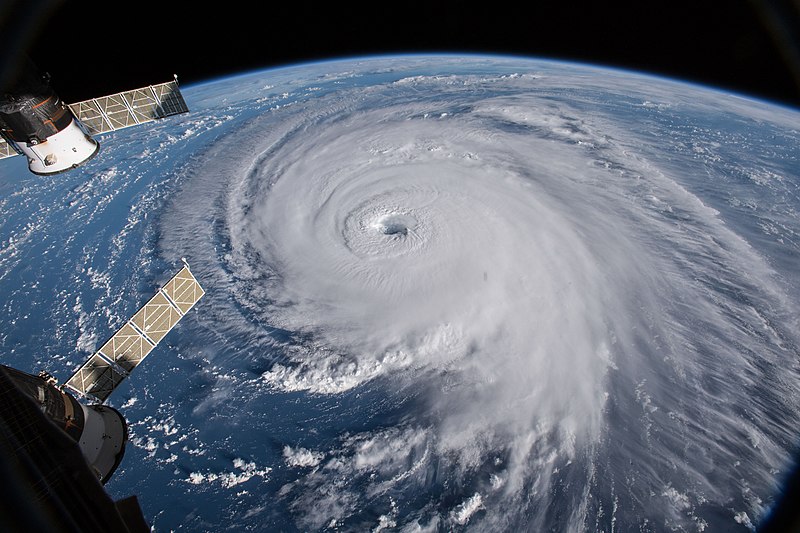Hurricane Florence floods Carolinas
From NASA Goddard Space Flight Center
Hurricane Florence is seen from the International Space Station on Sept. 12, when it was classified as a Category 3 hurricane. The hurricane has led to at least 48 deaths in North Carolina, South Carolina, Florida and Virginia, many due to the widespread storms and flooding it caused.
September 30, 2018
Hurricane Florence lashed North and South Carolina with widespread rains and flooding this month, leading to at least 48 deaths and billions of dollars worth of damage, after making landfall Sept. 14.
Governors in several states, including the Carolinas and Virginia, declared states of emergency and ordered residents nearest the coast to evacuate prior to the hurricane’s arrival.
Hurricane Florence, which reached the Category 4 classification but had been downgraded to Category 1 by the time it hit, also caused hundreds of thousands of residents to lose power and flooded major highways. Flooding led to river water levels surpassing records set by Hurricane Matthew, which hit South Carolina as a Category 1 hurricane in 2016.
“I know there were some regions like Wilmington on the coast which were severely impacted, and there were a lot of people that had to cope with really difficult situations. I’m just glad that that wasn’t as large of a scale here in Durham,” Vivek Sriram (’15), an undergraduate student at Duke University in North Carolina, said. “There was a lot of anxiety about it at the start of the week, so classes on Thursday and Friday were cancelled ahead of time. A lot of people stocked up on food, but when the storm ending up coming, it was a lot less severe than expected [for Duke].”
Flooding or threat of flooding persists in some Carolina areas even now, two weeks after the hurricane made landfall.
To help people affected by Hurricane Florence, many charities have established relief efforts, to which people can make donations of money or needed goods.


















![“[Building nerf blasters] became this outlet of creativity for me that hasn't been matched by anything else. The process [of] making a build complete to your desire is such a painstakingly difficult process, but I've had to learn from [the skills needed from] soldering to proper painting. There's so many different options for everything, if you think about it, it exists. The best part is [that] if it doesn't exist, you can build it yourself," Ishaan Parate said.](https://harkeraquila.com/wp-content/uploads/2022/08/DSC_8149-900x604.jpg)




![“When I came into high school, I was ready to be a follower. But DECA was a game changer for me. It helped me overcome my fear of public speaking, and it's played such a major role in who I've become today. To be able to successfully lead a chapter of 150 students, an officer team and be one of the upperclassmen I once really admired is something I'm [really] proud of,” Anvitha Tummala ('21) said.](https://harkeraquila.com/wp-content/uploads/2021/07/Screen-Shot-2021-07-25-at-9.50.05-AM-900x594.png)







![“I think getting up in the morning and having a sense of purpose [is exciting]. I think without a certain amount of drive, life is kind of obsolete and mundane, and I think having that every single day is what makes each day unique and kind of makes life exciting,” Neymika Jain (12) said.](https://harkeraquila.com/wp-content/uploads/2017/06/Screen-Shot-2017-06-03-at-4.54.16-PM.png)








![“My slogan is ‘slow feet, don’t eat, and I’m hungry.’ You need to run fast to get where you are–you aren't going to get those championships if you aren't fast,” Angel Cervantes (12) said. “I want to do well in school on my tests and in track and win championships for my team. I live by that, [and] I can do that anywhere: in the classroom or on the field.”](https://harkeraquila.com/wp-content/uploads/2018/06/DSC5146-900x601.jpg)
![“[Volleyball has] taught me how to fall correctly, and another thing it taught is that you don’t have to be the best at something to be good at it. If you just hit the ball in a smart way, then it still scores points and you’re good at it. You could be a background player and still make a much bigger impact on the team than you would think,” Anya Gert (’20) said.](https://harkeraquila.com/wp-content/uploads/2020/06/AnnaGert_JinTuan_HoHPhotoEdited-600x900.jpeg)

![“I'm not nearly there yet, but [my confidence has] definitely been getting better since I was pretty shy and timid coming into Harker my freshman year. I know that there's a lot of people that are really confident in what they do, and I really admire them. Everyone's so driven and that has really pushed me to kind of try to find my own place in high school and be more confident,” Alyssa Huang (’20) said.](https://harkeraquila.com/wp-content/uploads/2020/06/AlyssaHuang_EmilyChen_HoHPhoto-900x749.jpeg)










